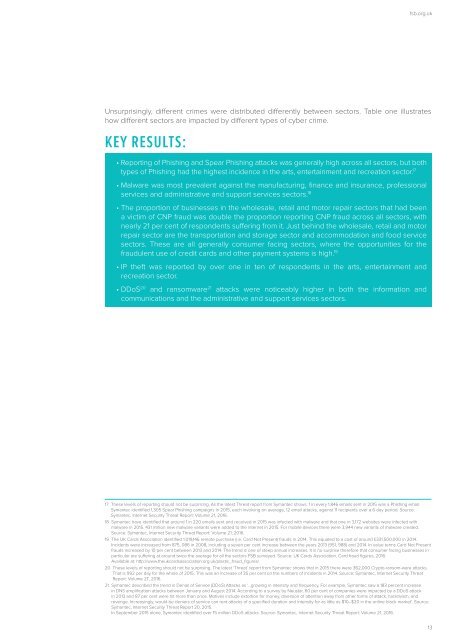CYBER RESILIENCE HOW TO PROTECT SMALL FIRMS IN THE DIGITAL ECONOMY
FSB-Cyber-Resilience-report-2016
FSB-Cyber-Resilience-report-2016
Create successful ePaper yourself
Turn your PDF publications into a flip-book with our unique Google optimized e-Paper software.
fsb.org.uk<br />
Unsurprisingly, different crimes were distributed differently between sectors. Table one illustrates<br />
how different sectors are impacted by different types of cyber crime.<br />
KEY RESULTS:<br />
• Reporting of Phishing and Spear Phishing attacks was generally high across all sectors, but both<br />
types of Phishing had the highest incidence in the arts, entertainment and recreation sector. 17<br />
• Malware was most prevalent against the manufacturing, finance and insurance, professional<br />
services and administrative and support services sectors. 18<br />
• The proportion of businesses in the wholesale, retail and motor repair sectors that had been<br />
a victim of CNP fraud was double the proportion reporting CNP fraud across all sectors, with<br />
nearly 21 per cent of respondents suffering from it. Just behind the wholesale, retail and motor<br />
repair sector are the transportation and storage sector and accommodation and food service<br />
sectors. These are all generally consumer facing sectors, where the opportunities for the<br />
fraudulent use of credit cards and other payment systems is high. 19<br />
• IP theft was reported by over one in ten of respondents in the arts, entertainment and<br />
recreation sector.<br />
• DDoS 20 and ransomware 21 attacks were noticeably higher in both the information and<br />
communications and the administrative and support services sectors.<br />
17 These levels of reporting should not be surprising. As the latest Threat report from Symantec shows, 1 in every 1,846 emails sent in 2015 was a Phishing email.<br />
Symantec identified 1,305 Spear Phishing campaigns in 2015, each involving on average, 12 email attacks, against 11 recipients over a 6 day period. Source:<br />
Symantec, Internet Security Threat Report: Volume 21, 2016.<br />
18 Symantec have identified that around 1 in 220 emails sent and received in 2015 was infected with malware and that one in 3,172 websites were infected with<br />
malware in 2015. 431 million new malware variants were added to the internet in 2015. For mobile devices there were 3,944 new variants of malware created.<br />
Source: Symantec, Internet Security Threat Report: Volume 21, 2016.<br />
19 The UK Cards Association identified 1,019,146 remote purchase (i.e. Card Not Present) frauds in 2014. This equated to a cost of around £331,500,000 in 2014.<br />
Incidents were increased from 875, 086 in 2008, including a seven per cent increase between the years 2013 (951, 988) and 2014. In value terms Card Not Present<br />
frauds increased by 10 per cent between 2013 and 2014. The trend is one of steep annual increases. It is no surprise therefore that consumer facing businesses in<br />
particular are suffering at around twice the average for all the sectors FSB surveyed. Source: UK Cards Association, Card fraud figures, 2016.<br />
Available at: http://www.theukcardsassociation.org.uk/plastic_fraud_figures/<br />
20 These levels of reporting should not be surprising. The latest ‘Threat’ report from Symantec shows that in 2015 there were 362,000 Crypto-ransom-ware attacks.<br />
That is 992 per day for the whole of 2015. This was an increase of 35 per cent on the numbers of incidents in 2014. Source: Symantec, Internet Security Threat<br />
Report: Volume 21’, 2016.<br />
21 Symantec described the trend in Denial of Service (DDoS) Attacks as ‘…growing in intensity and frequency. For example, Symantec saw a 183 percent increase<br />
in DNS amplification attacks between January and August 2014. According to a survey by Neustar, 60 per cent of companies were impacted by a DDoS attack<br />
in 2013 and 87 per cent were hit more than once. Motives include extortion for money, diversion of attention away from other forms of attack, hacktivism, and<br />
revenge. Increasingly, would-be deniers of service can rent attacks of a specified duration and intensity for as little as $10–$20 in the online black market’. Source:<br />
Symantec, Internet Security Threat Report 20, 2015.<br />
In September 2015 alone, Symantec identified over 15 million DDoS attacks. Source: Symantec, Internet Security Threat Report: Volume 21, 2016.<br />
13


